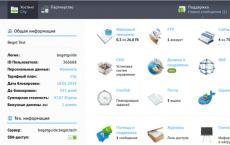Procedure for updating 1C 8.3 server instructions. Platform installation, platform update. Preparing work and blocking users during installation
If you see a window like this when you launch any 1C infobase, this means that you are working with an outdated platform and it needs to be updated:
Continuing to work with the current version of the platform is highly discouraged; this can lead to unpredictable consequences.
To update, you can contact a specialist, or you can do it yourself, there is nothing complicated. Let's look at how to update the 1C 8.3 platform yourself in two simple steps. This instruction is also suitable for migrating from the 1C 8.2 platform to 8.3.
If you already have the installation file, then proceed to the next section “Installation”.
So, go to the support site (https://users.v8.1c.ru/):

We are interested in the “Program Update” section.
On the next page of the site you need to enter the Login and Password that you received when concluding an agreement for information technology support (ITS):

Get 267 video lessons on 1C for free:

We are interested in the line “Technology platform 8.3”. Click on this link and you will be taken to a page with version numbers:

Naturally, we are interested in the latter, that is, the top one. Click on the link again and here select the platform for Windows ( This section contains platforms for Linux, and, and much more, it is important not to confuse them!):

Finally we can download the distribution. In the next window, click on the “Download distribution” link. Save the distribution to some folder on the disk. Your browser may automatically start the download if it has a default folder configured.
Now in Explorer we look for the downloaded file. The distribution file is an archive, so it must be unpacked into a separate folder.
Installation of the 1C platform
After unpacking, look for the setup.exe file in the list of files and run it:

The installation process will begin. It is no different from installing any other program; the only question may arise when a window appears with a choice of components to install.
Our video about installing the 1C 8.3, 8.2 or 8.1 update:
After updating the 1C platform, if necessary, you can proceed.
1C 8.3 server update
The process of updating the 1C platform on the server is no different from the regular update given above. The only condition is that you need to choose the right application distribution. Please note that the server application installation file comes in two types - 32 and 64 bit.
But when you install it for the first time, the default settings are already set to the minimum settings to get started. If other settings are needed (for example, if the information base is located on a server), then it is better to contact a specialist.
After installation, the program is ready for use, you can either add configurations, infobases and work.
For users and administrators of 1C programs
How to update the 1C Enterprise 8 platform on the server?
Dmitry Mironov
Today I want to tell you how to update the 1C Enterprise 8 platform in client-server mode.
Before the update we will need to do a little preparation.
1. View the number of the installed release on the serverTo do this, launch 1C, open any database located on the enterprise server and click on the help icon (or click “Help” - then “About the program”)
look at the release number:
In our case, this is a rather old release, version 8.2.15.318.
2. Download the required version of the platformNext, go to the website users.v8.1c.ru(to access the site you must have a subscription to ITS and received an account login and password).

Click "download updates" in the "Software updates" section. We enter our credentials and go to a page with available files for download.
Select "Technology platform 8.2".
We select the desired release (in this case, I install the latest version of the 16 releases, since the 17th version of the 8.2 platform is still somewhat damp).
Select the item "1C enterprise technology platform for windows"
And click on “Download”.
3. Make preparations before installation.Before installation, we need to make sure that no one is currently working in the 1C server databases. To do this, we go to the 1C enterprise administration console:
And we look at open sessions in all databases
In our case, no one works in the database. If everyone has been warned, but someone is not at work, or the user has forgotten to correctly exit the terminal session and continues to hang in the database, you can disable it by right-clicking, selecting “Delete”
Then you need to make backup copies of all databases (). And be sure to test unpack the backups!
We also need the password of the local user on whose behalf the enterprise 1C server is launched (by default it is usr1cv82). If you didn’t write down the password at the time, you can change it in computer management, users.
Upon completion of the preparatory steps, unpack the archive and run the file “setup.exe”
Now we check which components will be updated.
In the next window, leave everything as default and click “Next”. And in the new window we just enter the password for our local user.
Updating the 1c server from 8.2 to 8.3 will not cause any problems if you initially provide for a couple of points.
First, you need to kick users out of all 1C databases. After this, we stop the service - 1C:Enterprise Server Agent 8.2. and for reliability, it is necessary to disable automatic startup for this service. You can do it via the command line:
sc config "1C:Enterprise 8.2 Server Agent (x86-64)" start= disabled
sc stop "1C:Enterprise 8.2 Server Agent (x86-64)"
A space after “start=” is required.
Next, in Program Files, create the 1cv8 folder and copy the srvinfo directory from 1cv82 there. This is a very important point. If the folder is not copied, then the list of databases will not be transferred to the new server.
The old 8.2 server should never be deleted. In general, you don’t have to delete it at all, just in case.
Now we install server 1C 8.3.
During the installation process, you will be asked about the system language; if the OS on the server is English, then it is better to manually select the Russian language. Next, when selecting a user, leave the user from 8.2 and be sure to enter his current password in both fields below. There is no need to install a hardware license driver if PIN codes are used.
After successful installation of 8.3, go to the administration console and look at the list of databases, all databases should be connected.
After the 1c 8.3 server has been launched, you need to configure the operating parameters of the 1c server. In particular, memory consumption and the number of databases and users per 1 server worker process.
In the 1c server administration console, in the tree on the left, look for the “Local cluster” item, right-click on the mouse - Properties. We edit the parameter - “Allowed memory size”. I installed 2097152 Kb, that's 2GB. “Interval for exceeding the permissible memory capacity” is 60 seconds. If the process exceeds the allowed size, it will be restarted, with users all switching to another process.
Next, in the tree, open the “Working Servers” menu and on our server, right-click and select properties. Here you need to set the amount of memory that is available to the 1c server. This is indicated in the “Maximum memory size of work processes” item. Because The server only has 24GB of memory, so I set it to 22GB for 1s. In bytes it will be 23622320128.
Here we indicate the number of infobases per process and the number of connections per process. I indicated 1 and 15 respectively.
After making changes, it is not necessary to restart the server; all settings are picked up on the fly. Although it wouldn't hurt to restart to be safe. It is enough to restart the 1c server service.
Unlike 8.2, in 8.3 there is no need to manually create workflows; they are created automatically as needed
Have you encountered configuration errors after updating the 1C:Enterprise 8.2 platform? The problem is that they did not immediately update the 1C server where the developers work, and due to the difference in versions, errors began to appear in the Storage (to which both the Working DB and the developer databases are connected)! To avoid such troubles in the future, step-by-step (so as not to forget anything) instructions for updating the 1C:Enterprise 8.2 platform were compiled...
If you are using a large multi-user database, the development of which is carried out through storage, then to ensure the integrity of the configuration structure and to prevent errors with the configuration cache, you need to update the 1C:Enterprise 8.2 platform as follows:
(NOTE: Updating on servers and client machines should be done as installing a new version, and not as updating an existing one (to maintain the ability to roll back to a previous version of the platform))
- 1) Make a full copy of the working database using SQL Server;
- 2) Developers in their test databases should finish making changes and put all captured objects into the main storage, and disconnect from the Storage. Developers should then close all connections to their test databases;
- 3) Set a lock on the working database and close all sessions;
- 4) In the work base configurator, connect to the Storage and get all objects from the storage. Save all configuration changes and update the database configuration, disconnect from the Storage. Close the working database configurator;
- 5) Stop the “1C:Enterprise 8.2 Server Agent...” service on the production server. If the Server Cluster includes other production servers, you must also stop this service on these servers;
- 6) Make another full copy (to save the changes received from the Storage) or a differential copy (to save disk space) of the working database;
- 7) Make a copy of the working directory of the 1C Server Cluster. The path to this directory can be viewed on the central 1C server in the properties of the “1C:Enterprise 8.2 Server Agent...” service: parameter –d;
- 8) Update the 1C:Enterprise 8.2 platform on the central working server and on all other working servers included in the Server Cluster (to update, you need to run setup.exe and install through the Wizard). If a 64-bit version of the server is installed, then you need to run the corresponding installer. In addition, it is necessary to update the 32-bit components (Client applications, Cluster Console, and others);
- 9) Update the 1C:Enterprise 8.2 platform on computers that are 1C:Enterprise 8.2 servers for developers. The update is carried out in the same way as described in paragraph 8 of these instructions;
- 10) Update the 1C:Enterprise 8.2 platform on all other 1C servers (for example, servers on which Test DBs or backup 1C servers are located);
- 11) Check that on the central 1C server and on other working servers included in the 1C Server Cluster, the “1C:Enterprise 8.2 Server Agent...” service has started and is running;
- 12) Open the working database configurator and perform Restructuring of information security tables using the Information Security Testing and Correction tool;
- 13) Create a new storage from the working database configurator;
- 14) Make another full copy of the working database (to save the table restructuring) using SQL Server;
- 15) In all test databases of developers, connect to the NEW Storage, obtain all data, save and update configurations;
- 16) On all other test databases not associated with the Storage, perform the operation described in paragraph 12 OR restore these databases from the last copy of the working database with the restructuring performed (see paragraph 14);
- 17) On developer computers, clear the cache of 1C:Enterprise 8.2 configurations;
- 18) Update the 1C:Enterprise 8.2 client application on user computers and the terminal server;
- 19) Check the correctness of the nethasp.ini configuration file (problems with network security keys);
- 20) Perform a test run of the working database from a client machine under user rights (launch from an updated platform)
Send this article to my email
Often, a user working with a 1C program is faced with the need to switch to a newer version of the working configuration (this may be due to correction of errors in the current configuration, the need for new mechanisms included in the new version, etc.). And for the program to work correctly on the new version of the configuration, there may also be a need to update the 1C Enterprise platform.
In this article we will look at how to update the 1C 8.3 platform.
The update process involves installing a new version of the technology platform; it is installed in parallel with the old one, and you can work under each version of the platform. This is not at all difficult to do; the process is well established and does not require any special skills.
First, you will need to download the distribution kit for the current version of the platform you want to install. To do this, you need a subscription to the ITS and, accordingly, credentials confirming it: login and password. The official 1C support website is located at https://users.v8.1c.ru/. Having opened the site on the user support page, you need to find and click the Download updates link.

Here, if you have not previously logged into the site and did not save your credentials for it, a window will appear in which you must enter your login and password. Next in the list, expand the Technology distributions menu and find the line Technology platform 8.3.
Clicking on a line opens a page with published versions of the selected platform.


Select the current one (see number and release date). Next in the list, find and select the line 1C:Enterprise Technology Platform for Windows.

Then click Download distribution.

After downloading data from the site is completed, you need to find the folder where the file was saved (the storage location of the downloaded file depends on your browser settings; you may be asked to specify the folder when downloading), as a rule, this is the Downloads or Download folder, which can be opened through Explorer. The distribution file is an archive that must be unpacked into a separate folder. After unpacking, find the setup.exe file and run it. The installation process will begin, it is very simple, you just need to confirm the installation steps sequentially.

After installation, you can start working with the selected infobase on the new version of the platform.
An automatic update setting is also available. The Program Update assistant is designed for this (does not work in client-server mode).
It is located in the administration section in the Service → Program Update section, or you can find it in the All functions → Processing → Program Update menu.
The processing contains information about the available update of the 1C:Enterprise platform: version number, distribution size and a link to information about the features of the transition to a new version of the 1C:Enterprise platform. During processing, you must select the platform installation mode, indicate the need to store platform distributions on your computer and create a backup copy.



